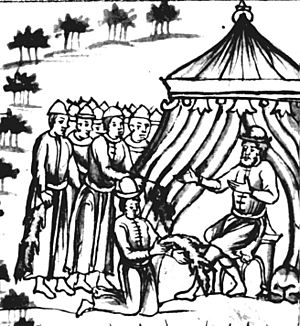Yasak facts for kids
Yasak (pronounced yah-SAHK) was a special payment, usually made with valuable furs, that people living in Siberia had to give to the Russian Empire. It's a word that comes from the Turkic languages and means "tribute" or "tax."
What is Yasak?
The idea of yasak started a long time ago with the Mongol Empire, especially in a part called the Golden Horde. It was a tax collected from people who were not Mongols, often those who spoke Turkic languages. The word "yasaq" comes from the Turkic word "Zhasaq," which has two main meanings:
- It could mean "This is what you have to do," referring to a set of rules or laws from the time of Genghis Khan, a famous Mongol leader.
- It could also mean a "ten-man troop." These small groups of soldiers would collect a part of people's earnings for the Golden Horde. Over time, their name became linked to the tax they collected.
The Russian Empire likely learned about yasak from the khanates (kingdoms) of Kazan and Astrakhan, which were once part of the Golden Horde. When Ivan the Terrible conquered these areas in the 1550s, he continued the practice of collecting yasak from the local people. They would pay with things like grain or fish.
How Yasak Worked

Voguls giving fur as a tribute to Yermak Timofeyevich.
|
As Russia expanded into Siberia in the 1600s, yasak became a common practice there. It was like a trade: native people would give furs as yasak, and in return, the Russian Tsar (emperor) would give them gifts. These gifts often included useful items like tobacco, flint stones, knifes, and axes. Sometimes, people in the Far East even received colorful crystal beads. Local Russian officials, called voyevodas, might also give food like fish oil.
Sometimes, if the Tsar's gifts weren't good enough or seemed too cheap, the people paying yasak would get upset. There were times when they would even throw the gifts away or tie them to dogs! These disagreements could sometimes lead to rebellions against the Russian government.
Over many years, Russian officials tried to change yasak from a simple exchange of gifts into a regular, fixed tax. This process took a very long time. In some areas, giving gifts to local leaders was the only way to get people to cooperate. By the 1720s, yasak was replaced by a regular tax in the Volga River region. Most of Siberia followed in 1822. However, a small, symbolic form of yasak continued for some nomadic groups in Eastern Siberia, like the Yakuts and Evenks, until the Russian Revolution of 1917.
Collecting Yasak
The way yasak was collected wasn't always the same everywhere. It changed from one area to another. To figure out who needed to pay, officials would take a census (a count of people). The results were written down in "yasak-books." We still have over 1,700 of these books from the 1600s!
Every male between 18 and 50 years old who had to pay yasak also had to take an oath of loyalty to the Tsar. Most people in Siberia paid yasak based on each household. However, the Yakut people paid based on how many cattle they owned, and the Bashkir people paid based on a land survey.
Yasak was usually paid in valuable furs like sables, red foxes, beavers, and martens. Sometimes, cattle were also accepted. These fur payments were very important for Russia's fur trade with Western Europe.
At first, a special government office in Muscovite Russia called the Siberian Prikaz was in charge of collecting yasak. In 1727, a law said that yasak could be paid in cash, but this didn't make enough money for the government, so it was changed back to furs twelve years later.
Later, Catherine the Great made some changes to how yasak was collected. She set up "yasak commissions" with a main office in Tobolsk. By 1827, two main commissions were responsible for collecting yasak, one for Eastern Siberia and one for Western Siberia.
See also
 In Spanish: Yasak para niños
In Spanish: Yasak para niños

